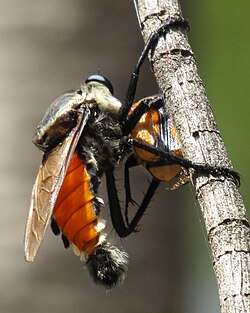Biology:Blepharotes coriarius
| Blepharotes coriarius | |
|---|---|

| |
| Giant Yellow Robber Fly (Blepharotes coriarius) with beetle prey. | |
| Scientific classification | |
| Kingdom: | |
| Phylum: | |
| Class: | |
| Order: | |
| Family: | |
| Subfamily: | |
| Genus: | |
| Species: | B. coriarius
|
| Binomial name | |
| Blepharotes coriarius Wiedemann, 1830
| |
Blepharotes coriarius, the giant yellow robber fly, is a species of large predatory fly from Australia in the family Asilidae (robber flies). It was described by the German naturalist Christian Rudolph Wilhelm Wiedemann in 1830.[1]
Description
B. coriarius is one of the largest known robber flies.[2] It can measure up to 48mm in length (including proboscis).[2] Both sexes have orange abdominal tergites, with patches of black setae along the sides of segments 1-5 and mostly white setae along the sides of segments 6 and 7.[3]
Distribution
The giant yellow robber fly is found in the Australian states of Queensland, New South Wales, Victoria, South Australia and Western Australia.[4]
Behaviour
Adults can be found from December to February.[3] They are usually seen resting on dead plants, with the body aligned vertically and the head pointing upwards.[3] Insect prey are taken in the air after the fly launches itself from a vantage point.[3] Recorded prey items include beetles, bees, wasps and flying ants.[3] Feeding time varies from less than two minutes (for a large ant) up to 17 minutes (for a scarab beetle).[3]
Males of B. coriarius attempt to mate with any member of the same species (whether male or female) that enters their territory, which is usually the area around a dead tree.[3] Intruding males are driven off by this.[3] A few minutes after successful copulation, females begin laying eggs into gaps of dead eucalypts, or into cracks in the ground at the base of such trees.[3] She generally begins oviposition in the top soil, before gradually flying up the tree, depositing more eggs as she goes.[3]
Pupae first emerge from the soil at the beginning of December.[3] The pupal cases are around 35mm long, with reddish brown spines and processes glistening reddish brown to dark brown.[3]
References
- ↑ "Australian Faunal Directory". https://biodiversity.org.au/afd/taxa/Mydas_giganteus.
- ↑ 2.0 2.1 Bromley, S.W. (September 1927). "The Genus Microstylum in Madagascar (Diptera: Asilidae)". Transactions of the American Entomological Society 53 (3): 201–207. https://www.jstor.org/stable/25077179.
- ↑ 3.00 3.01 3.02 3.03 3.04 3.05 3.06 3.07 3.08 3.09 3.10 3.11 Weber, Gerhard; Lavigne, Robert (2004). "Notes on the behaviour of Blepharotes coriarius (WIEDEMANN, 1830) (Diptera: Asilidae) with a description of the pupal case". Studia dipterologica 11 (1): 13–21. https://www.academia.edu/27313144.
- ↑ "Blepharotes coriarius". https://bie.ala.org.au/species/https://biodiversity.org.au/afd/taxa/22a98eec-ecfc-44d5-be39-6fc864d642e5.
Wikidata ☰ Q4926158 entry
 |

